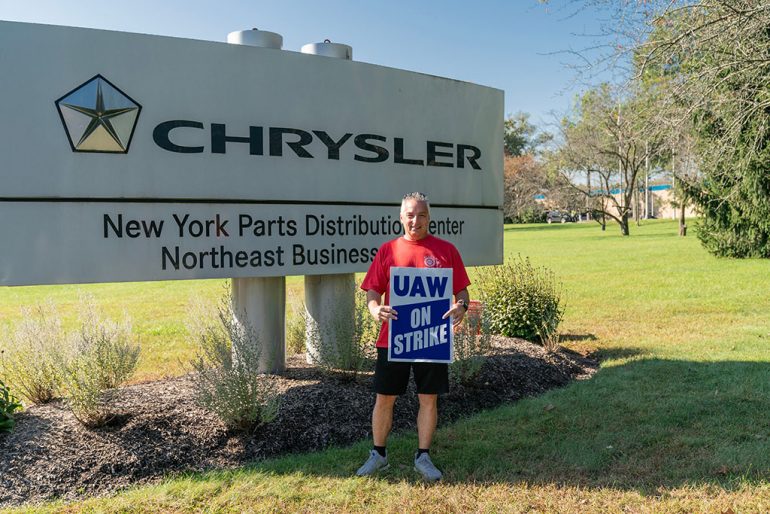
Chrysler-owned Stellantis recently reached a deal with the United Auto Workers (UAW) to end a strike, while General Motors (GM) found itself grappling with expanded walkouts. These developments are significant within the automotive industry, as they not only impact the companies and their workers but also hold broader implications for the American labor movement.
The UAW decided to extend its strike against GM to include the engine plant in Spring Hill, Tennessee. This expansion raised concerns about potential disruptions in GM’s large pickup production and their financial well-being. With this expansion, GM was left as the sole Detroit automaker without a contract deal, as both Stellantis and Ford had already reached agreements with the UAW. These agreements included a substantial 25% increase in wages over a 4.5-year contract period, enabling the automakers to restart their profitable truck assembly lines.
Within the ongoing negotiations with GM, sticking points revolved around issues such as retirement benefits and the treatment of temporary workers. GM faced unique challenges due to having more retirees than its competitors, resulting in higher pension benefit costs for workers hired before 2007. The UAW expressed disappointment with GM’s reluctance to reach a fair agreement, emphasizing the urgency of the situation.
The strike at GM’s Arlington, Texas assembly plant, which manufactures popular models like the Chevy Tahoe, Suburban, and Cadillac Escalade, had already been costing the company $400 million weekly. Now, with the Spring Hill plant’s inclusion in the strike, GM was facing even greater financial pressure. The Spring Hill plant, employing approximately 4,000 workers, supplied engines to nine assembly plants responsible for many of GM’s best-selling and most profitable vehicles.
As the strike unfolded, UAW lawyer Benjamin Dictor highlighted the contrast between GM and other automakers, which had successfully concluded negotiations. This situation posed a significant challenge for GM’s production and its standing within the industry.
The situation did not promise a swift resolution, as no further talks were expected on that Saturday, and the timing of GM and UAW’s return to the negotiating table remained uncertain.
In contrast, Stellantis, following a template set by the UAW and Ford, reached an agreement. These deals offered substantial pay hikes, exceeding 33% when considering compounding and cost-of-living adjustments. The contracts would initiate with an 11% pay increase, a development welcomed by Stellantis, although ratification by all workers was still required.
The U.S. President, Joe Biden, acknowledged the power of unions and collective bargaining in creating middle-class jobs, applauding the Stellantis deal. The agreement also included the reopening of Stellantis’ assembly plant in Belvidere, Illinois, which would now produce midsize trucks, potentially competing with models from Ford and GM. Stellantis agreed to construct a battery plant next to the Belvidere facility.
Illinois Governor Jay Pritzker praised the agreement for preserving jobs in his state and promised incentives to support the automaker’s efforts. Stellantis also reversed its decision to close two facilities – an engine manufacturing complex in Trenton, Michigan, and a machining operation in Toledo, Ohio. The company pledged $19 billion in new investments and the creation of 5,000 jobs in the United States, a significant deviation from its previous plan to cut 5,000 jobs.
The UAW’s success in securing the right to strike over product investment decisions reflected their influence in these negotiations. UAW President Shawn Fain highlighted the perceived disparity between executives’ and investors’ gains and the workers’ concerns, asserting that the UAW’s success would benefit blue-collar workers across the country.
However, the automakers argued that the UAW’s demands would lead to increased costs, potentially putting them at a disadvantage compared to electric vehicle leader Tesla and foreign nonunionized brands like Toyota. Ford anticipated that the new contract would add $850 to $900 in labor costs per vehicle, highlighting the challenge in maintaining competitiveness in the industry.
These labor negotiations were taking place in a broader context where the labor movement seemed re-energized, with high-profile strikes by Hollywood writers, actors, and workers at UPS, driven by staff shortages in various industries. The significance of these negotiations extended beyond the automotive sector, as both President Biden and his Republican rivals recognized the importance of auto-producing states like Michigan in their 2024 campaign strategies.

Mike Floyd is a finance executive by trade and a car enthusiast at heart. As a CFO with a keen eye for detail and strategy, Mike brings his analytical mindset to the automotive world, uncovering fresh insights and unique perspectives that go beyond the surface. His passion for cars—especially his favorite, the Porsche 911, fuels his contributions to Automotive Addicts, where he blends a love for performance and design with his professional precision. Whether he’s breaking down industry trends or spotlighting emerging innovations, Mike helps keep the site both sharp and forward-thinking.